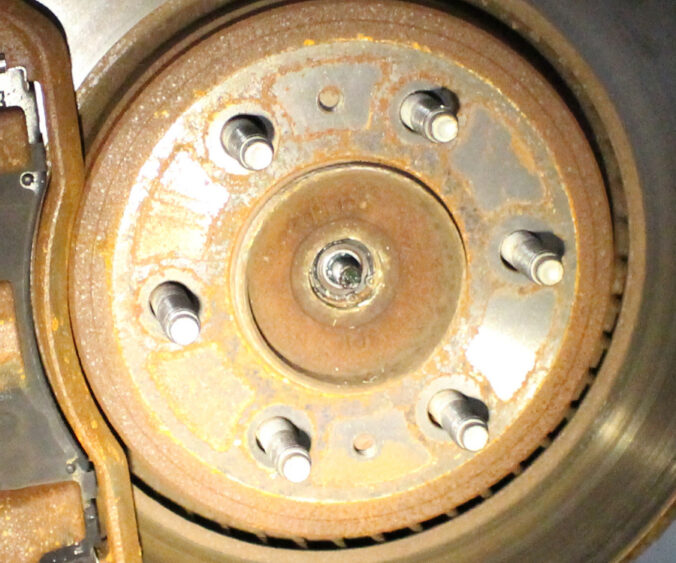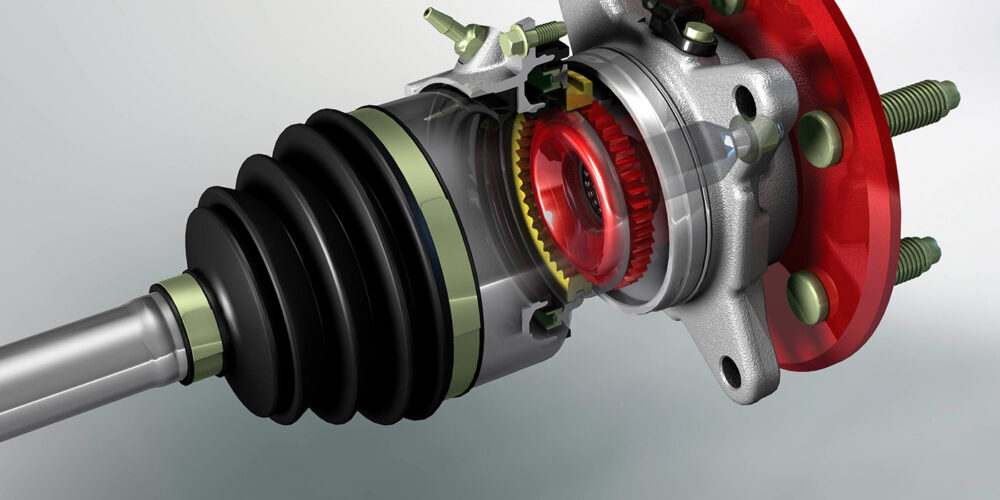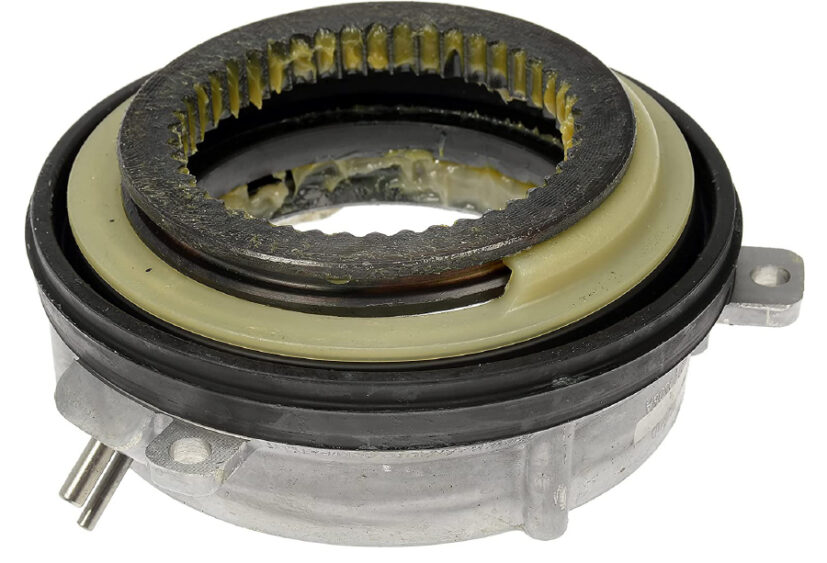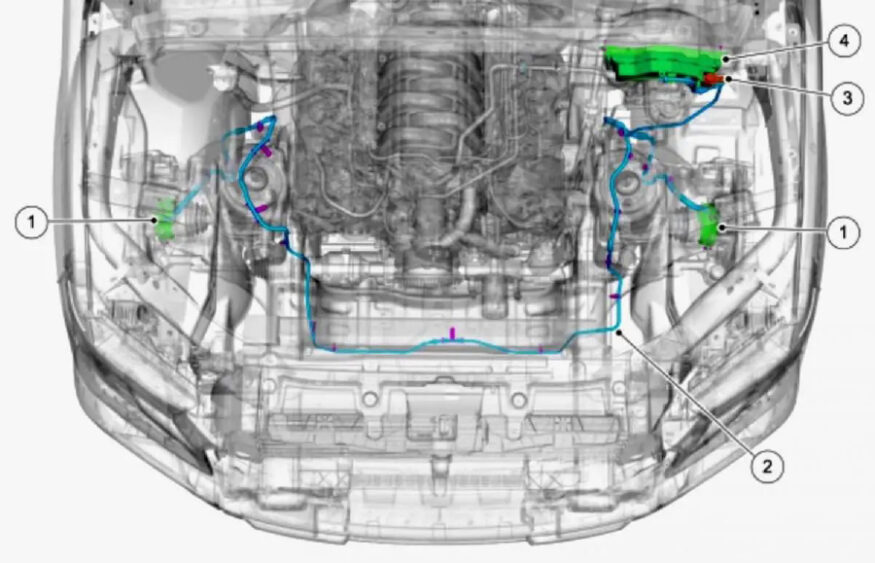Ford’s Integrated Wheel End (IWE) first hit the market in 2004 on the F-150, Expedition and Lincoln Navigator. An IWE allows the front wheels to rotate while the front axles do not move and turn the front differential. This helps to improve fuel economy.
Compared to the older vacuum actuated locking hubs, IWEs operate in reverse. When in 2WD mode, a vacuum is applied to the IWE unit. This pulls a splined collar called the clutch ring back that disconnects the axle from the hub unit and front wheels. When the vacuum is not present like in 4WD mode, the splined clutch ring connects the axle to the hub unit. The system is designed to allow for 4WD operation as a default, even if the solenoid is not working or is leaking.
The IWEs are controlled by the transfer case control module (TCCM), rather than a physical switch on the dash. IWE engagement occurs only once per key cycle and is not reset when shifting between PARK and DRIVE. The TCCM uses this strategy to delay vacuum use until vacuum-intensive engine startup has been completed and sufficient vacuum is available to fully disengage the IWEs. According to Ford, when the ambient temperature is below 32°F, the IWEs stay engaged for approximately 0.5 miles, regardless of a 4WD mode selection.
Symptoms
The leading customer complaint will be clicking, ratcheting or grinding noises when the truck is in 2WD mode. The noise is caused when the IWE unit is partially engaged in the clutch ring that is not fully seated. This is typically due to a partial vacuum being applied to the IWE. Partial engagement can cause rapid wear to the splines on the axle and wheel bearing hub unit. But, since the clutch ring is made of softer metal, it will take the brunt of the abuse.
If the unit has failed or there is no vacuum at the IWEs, the front axles will be connected to the wheels in 2WD. As a result, there might be increased noise levels. Also, they will notice decreased fuel economy.
Drivers may also complain of a less noticeable ticking or whining noise. This could be caused by damaged needle bearings inside the wheel bearing hub unit that allows the wheel to spin independently of the axle. Damage to these bearings can occur when the axle is installed into the hub.
Root Causes
The leading cause of IWE failure is water finding its way into the vacuum lines under the hood and in the wheel well. Under the hood, the IWE solenoid is positioned below the windshield and can be drenched in water. Later models and updated solenoids use a plastic shield over the solenoid. Eventually, the IWE solenoid was moved next to the brake booster.
The IWE units are the lowest point in the system, and water will go into the units thanks to gravity. In the wheel wells, the seals around the IWE vacuum unit can leak and suck water. Water is not good for the hubs because it dilutes the grease’s additive package and causes wear. Also, not using a premium OE-quality wheel bearing hub unit with excessive lateral and end play can cause issues with the engagement. So choosing a premium OE quality hub will ensure if there is a failure in the vacuum system allowing water to pool in the systems lowest point you will have the greatest chance of keeping water out of the hub bearing assembly due to the high quality seals used.
Inspection and Testing
When inspecting the truck, first perform basic checks like tires for pressure and wheel bearings for play. Next, look under the hood to see if any hoses are detached from the intake manifold or IWE solenoid. Also, scan the entire vehicle for codes. For example, P0171 or P0174 codes for lean conditions can indicate a vacuum leak.
When going on a test drive, try to ensure the ambient temperature is above 32º F, and the engine has been running for at least five minutes. Test in 2WD mode first to replicate the noise. Then, try switching to 4WD mode to see if the noise changes. The system might take 0.5 miles to engage and disengage the IWEs. Also, try at least two key cycles and observe how the IWEs perform.
Quick Test for System Vacuum
- Open the hood and find the IWE solenoid. The solenoid is located on the passenger’s side behind the battery on older trucks. On 2013 and newer trucks, the solenoid was moved next to the brake booster on the driver’s side.
- Connect a vacuum pump to the hose going to the IWE units.
- According to Ford TSB 20-2028, apply 508 mm-Hg (20 in-Hg) of vacuum. The readings should not drop more than 12.5 mm-Hg (0.5 in-Hg) per minute. If the system can’t hold a vacuum, you know one of the IWEs is leaking. If the vacuum does not fall, inspect the solenoid for damage and the connection to engine vacuum.
Note: You can use a smoke machine to detect leaks in the vacuum lines under the hood and in the wheel wells.
Individual IWE Testing
- Remove the hose going to the IWE.
- Connect your hand vacuum pump to the larger diameter port (the smaller port is the vent).
- Apply 508 mm-Hg (20 in-Hg) of vacuum.
- Inspect to see if the wheel moves and if the CV joint does not. If the CV joint moves, the internal diaphragm could be damaged. If there is excessive noise, it means that the splines are damaged.
- To test for vacuum decay, apply 508 mm-Hg (20 in-Hg) of vacuum. The readings should not drop more than 12.5 mm-Hg (0.5 in-Hg) per minute.
Testing the Solenoid
Diagnosing the solenoid that controls the vacuum to the IWEs requires a scan tool that can communicate with the TCCM. Then, with a vacuum gauge connected to the outlet of the solenoid and the engine running, actuate the solenoid using the special function test. At idle, the vacuum supply should be constant. If no vacuum is present, inspect or bypass the check valve connected to the solenoid. This is a common failure.

Repair Tips
- When replacing a wheel bearing or any repair that involves removing the axle from the hub unit, take care not to damage the IWE seals.
- Before tightening the axle nut, ensure the clutch ring is engaged on the axle and hub unit.
- There are updates to the software for the TCCM that changes how the solenoid controls the IWEs. The update can help to extend the life of the clutch rings.
- Make sure the knuckle and axle splines are clean before assembly. Small pieces of debris can damage the needle bearing in the wheel bearing hub or the seals of the IWE.
















